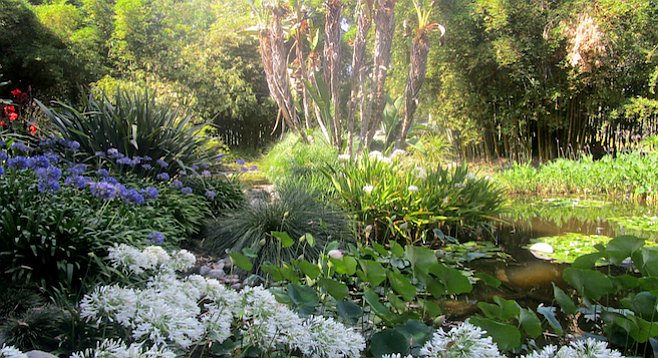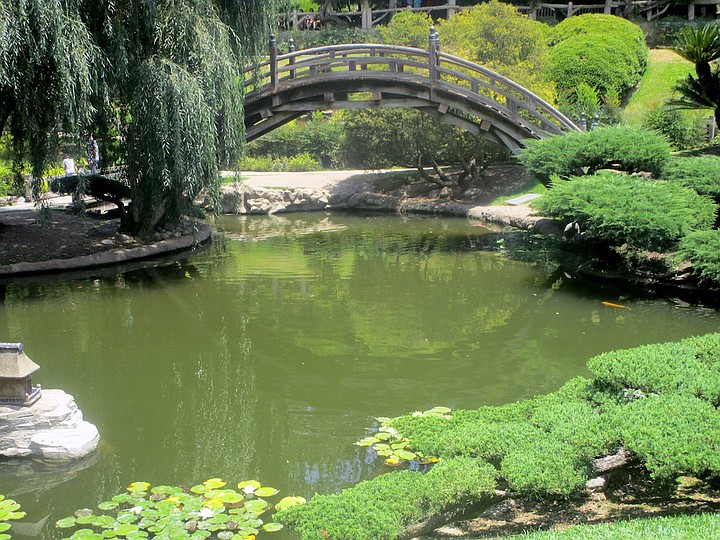 Facebook
Facebook
 X
X
 Instagram
Instagram
 TikTok
TikTok
 Youtube
Youtube

Looking for a hidden gem of a day trip from San Diego?
The Huntington Library and Botanical Gardens, a private nonprofit organization located in tony San Marino near Pasadena, is one of the best possible excuses to slog a congested freeway up to Los Angeles. The Huntington reveals itself as a true oasis amidst the hubbub of the megalopolis. Once you’re in the quiet confines of the wide-ranging exquisite gardens covering 120 acres, you’ll realize the trip was worth it.
If you’re rushed, the Huntington can’t be fully savored. Set aside the better part of a day for a visit here — and a full day if possible. Try to arrive early before the crowds emerge. Visiting the gardens and impressive collection of historical artifacts makes for a rewarding day.

The Botanical Gardens include a Chinese Garden, Japanese Garden, Rose Garden, Shakespeare Garden, Australian Garden, Jungle Garden, Children’s Garden, Palm Garden, Subtropical Garden, Lily pad Garden, and an outstanding twelve-acre Desert Garden. The Japanese Garden — with its serene ambience, beautiful landscape gardening, bucolic moon-shaped bridge, pavilions, koi-filled waterways and impressive bonsai collection — is my favorite. Strolling through these well maintained gardens may inspire you to slow down, reflect, relax, and languish in the verdant greenery. Yes, in L.A.!
You have the option of taking a guided docent tour, an audio tour or strolling the gardens on your own. The gardens are at different levels, which may prove to be a challenge for seniors, but a free tram service is just a quick call away. The free maps available at check in are invaluable in navigating the gardens. But if you want to just wing it and wander about aimlessly, letting the environs surprise you, there’s some fun in that too. Better to get lost here than on nearby freeways.
No matter how inviting the gardens are, set aside some time to visit the library. The wealth of historical documents and manuscripts there, particularly those encompassing American and British history and literature, are stunning. Included are handwritten letters by Abraham Lincoln and Sir Isaac Newton, notebooks of Keats and Chaucer, a Gutenberg Bible, an original First Folio collection of plays by William Shakespeare dating to 1623, and the oldest complete, original manuscript of The Canterbury Tales by Chaucer. The latter might explain why I traversed Chaucer Drive and Canterbury Drive on the road leading to the Huntington. Also in the library are documents by Henry David Thoreau, Mark Twain (first editions of his works with handwritten revisions), Oliver Cromwell, Ben Franklin, Ralph Waldo Emerson, and many other prominent historical and literary figures. There are also special exhibits worth checking out.

The Huntington also has an extensive collection of American and British art. The American collection covers the late 17th to the mid-20th century, while the British collection focuses on the 15th to the mid-20th century. Gainsborough’s Blue Boy is a notable work here. There are several paintings by Reynolds, Constable, Turner, and one of the world’s best collections of works by William Blake.
The Huntington Library and Botanical Gardens was the brainchild of tycoon Henry Huntington, nephew of Collis P. Huntington, one of the four major railroad barons of the era.
Huntington, an avid book, plant, and art collector, first visited the site, then a working ranch, in 1892. After Collis died, the younger Huntington inherited half his uncle’s wealth. He later married his uncle’s wife who had inherited the other half of the fortune (but that’s another story). In 1903 he bought the property and began transforming it into his vision as a legacy for future generations. By 1928, a year after Henry’s death, it was open to the public.
Nearly a century later, 700,000 people visit Huntington Gardens and Library annually and a staff of 400 keep it going. Over 1,700 scholars use the library collections each year and over 425,000 rare materials are used annually in the reading room. In the small wing adjacent to the library, informative displays reveal how materials are repaired and preserved. Also presented is a history of printing and bookmaking. Additionally, an audio visual guide provides some insights, through the words of Huntington employees, into the various jobs that keep the Huntington’s vast research services functioning smoothly. One of the researchers spoke with awe at the access she had to what seemed like “an infinite amount of material.”
After you enter the grounds, check out the worthwhile orientation film that gives a historical perspective on the site and its founder. You can then choose between heading to the library to view the collection of documents and exhibits, the art museums to peruse an extensive collection of British and American art, or the aforementioned gardens.
There is a reasonably priced self-service café near the entrance with a wide selection as well as a shop where you can pick up a book or memento to remember your trip. The ornate Rose Garden English Tearoom is worth a visit, but make reservations first.
General admission to the gardens and library is $23 on a weekday and $25 on a weekend. If you think you might want to return several times a year it may be cost-effective to buy a membership. The gardens are open 10-5 daily except Tuesday when they are closed. Parking is free. Bring a hat, water, sunscreen, good walking shoes and enjoy!


Looking for a hidden gem of a day trip from San Diego?
The Huntington Library and Botanical Gardens, a private nonprofit organization located in tony San Marino near Pasadena, is one of the best possible excuses to slog a congested freeway up to Los Angeles. The Huntington reveals itself as a true oasis amidst the hubbub of the megalopolis. Once you’re in the quiet confines of the wide-ranging exquisite gardens covering 120 acres, you’ll realize the trip was worth it.
If you’re rushed, the Huntington can’t be fully savored. Set aside the better part of a day for a visit here — and a full day if possible. Try to arrive early before the crowds emerge. Visiting the gardens and impressive collection of historical artifacts makes for a rewarding day.

The Botanical Gardens include a Chinese Garden, Japanese Garden, Rose Garden, Shakespeare Garden, Australian Garden, Jungle Garden, Children’s Garden, Palm Garden, Subtropical Garden, Lily pad Garden, and an outstanding twelve-acre Desert Garden. The Japanese Garden — with its serene ambience, beautiful landscape gardening, bucolic moon-shaped bridge, pavilions, koi-filled waterways and impressive bonsai collection — is my favorite. Strolling through these well maintained gardens may inspire you to slow down, reflect, relax, and languish in the verdant greenery. Yes, in L.A.!
You have the option of taking a guided docent tour, an audio tour or strolling the gardens on your own. The gardens are at different levels, which may prove to be a challenge for seniors, but a free tram service is just a quick call away. The free maps available at check in are invaluable in navigating the gardens. But if you want to just wing it and wander about aimlessly, letting the environs surprise you, there’s some fun in that too. Better to get lost here than on nearby freeways.
No matter how inviting the gardens are, set aside some time to visit the library. The wealth of historical documents and manuscripts there, particularly those encompassing American and British history and literature, are stunning. Included are handwritten letters by Abraham Lincoln and Sir Isaac Newton, notebooks of Keats and Chaucer, a Gutenberg Bible, an original First Folio collection of plays by William Shakespeare dating to 1623, and the oldest complete, original manuscript of The Canterbury Tales by Chaucer. The latter might explain why I traversed Chaucer Drive and Canterbury Drive on the road leading to the Huntington. Also in the library are documents by Henry David Thoreau, Mark Twain (first editions of his works with handwritten revisions), Oliver Cromwell, Ben Franklin, Ralph Waldo Emerson, and many other prominent historical and literary figures. There are also special exhibits worth checking out.

The Huntington also has an extensive collection of American and British art. The American collection covers the late 17th to the mid-20th century, while the British collection focuses on the 15th to the mid-20th century. Gainsborough’s Blue Boy is a notable work here. There are several paintings by Reynolds, Constable, Turner, and one of the world’s best collections of works by William Blake.
The Huntington Library and Botanical Gardens was the brainchild of tycoon Henry Huntington, nephew of Collis P. Huntington, one of the four major railroad barons of the era.
Huntington, an avid book, plant, and art collector, first visited the site, then a working ranch, in 1892. After Collis died, the younger Huntington inherited half his uncle’s wealth. He later married his uncle’s wife who had inherited the other half of the fortune (but that’s another story). In 1903 he bought the property and began transforming it into his vision as a legacy for future generations. By 1928, a year after Henry’s death, it was open to the public.
Nearly a century later, 700,000 people visit Huntington Gardens and Library annually and a staff of 400 keep it going. Over 1,700 scholars use the library collections each year and over 425,000 rare materials are used annually in the reading room. In the small wing adjacent to the library, informative displays reveal how materials are repaired and preserved. Also presented is a history of printing and bookmaking. Additionally, an audio visual guide provides some insights, through the words of Huntington employees, into the various jobs that keep the Huntington’s vast research services functioning smoothly. One of the researchers spoke with awe at the access she had to what seemed like “an infinite amount of material.”
After you enter the grounds, check out the worthwhile orientation film that gives a historical perspective on the site and its founder. You can then choose between heading to the library to view the collection of documents and exhibits, the art museums to peruse an extensive collection of British and American art, or the aforementioned gardens.
There is a reasonably priced self-service café near the entrance with a wide selection as well as a shop where you can pick up a book or memento to remember your trip. The ornate Rose Garden English Tearoom is worth a visit, but make reservations first.
General admission to the gardens and library is $23 on a weekday and $25 on a weekend. If you think you might want to return several times a year it may be cost-effective to buy a membership. The gardens are open 10-5 daily except Tuesday when they are closed. Parking is free. Bring a hat, water, sunscreen, good walking shoes and enjoy!
Comments